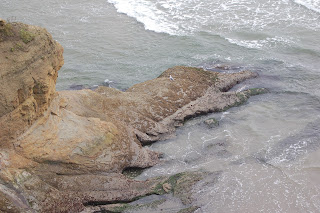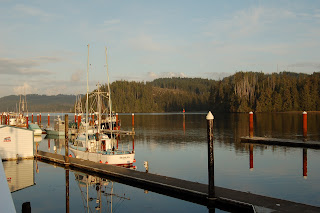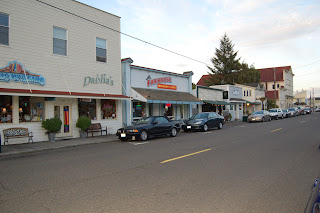From Crescent City we headed to Jedidiah Smith State and National Park but not, of course, before enjoying breakfast at Great Harvest Restaurant, the same restaurant we dined at the night before. From the coffee to the orange juice to pancakes, amelette, bacon and sausage, we ate well. The restaurant prides itself on organic, healthy food. The coffe was local roasted; the orange juice fresh squeezed. The eggs were not only local but cooked in either rice or olive oil. Real butter was used on the toast, pancakes, and potatoes. The potatoes were small reds, done well to our liking. The bacon and sausage was local and free of nitrates. We ate well and much!
Our drive to the Redwoods gave proof we were no longer in Oregon. The coast was not rocky; the grasses were brown. We actually drove through a corridor of tall trees isolated from the park giving us a hint of what was coming. When we entered the park through an access not popularly used, the road was one car narrow and wound through the trees, so tall it took three pictures to cover one tree from trunk to top. The width of these trees varied. The widest more than a car width. The sun was obscured by tree tops. No breezes blew where we were. The stillness and the quiet were notable. We took three walks, each giving different perspectives of the land and the trees, themselves. Yes, they were all redwoods, and tall, yet each tree had its own story, its own character. To see one was not to see all. I'm afraid my pictures do not do them justice.
Remember, I'm standing below holding my camera as high as I can pointing straight up! You still can't see the top.
The roots of these giants don't go much deeper than six to ten feet. We read that they are subject to high winds and floods. What holds them up is that the roots spread far and wide and tangle with the roots of their neighbors forming quite a web.
Sometimes they fall. When that happens, they may take down others in their path or somehow find a path with no resistance. These fallen giants helped us truly appreciate their size.
One of the paths we trod.
Compare the size of the trunk of this tree to Roger's height.
Another effort to show how tall they are and how dark is was at their base.
Not a tall tree but a wonderful twist. The vegetation on the ground around these trees is predominantly ferns. A few deciduous trees manage to grow but they are dwarved in size and number.
Ashland was a small town of a little over 20,000 and the home of a university. We found it a vital, upscale city. Clean, inviting, offering several book stores, both new and used, as well as antique venues. Bicycles and outdoor outfittting were in abundance. The people were either out age and sporting a 60's look or much younger and sporting tatoos and piercings. In other words, the inhabitants were a colorful bunch. We passed several tempting restaurants and a couple of historic hotels. Ashland is home to a Shakekspeare festival and that was in evidence everywhere. We checked out Omar's, the 1946 oldest restaurant in town. We had dessert, decadent and large, at an upper crust restaurant attached to one of the historic hotels I mentioned above.
We were back in Oregon and getting from the redwoods to Ashland meant passing numerous vineyards and orchards. We were back in lush, productive country.
On our way to either Jacksonville or Crater Lake, I'm not sure which, we stopped to take a botanical trail. The feature here was the "darlingtonia" (I think that's the name but maybe not the spelling). They get their nutrition from insects that get trapped in their "pitchers".
Jacksonville, Oregon, one main street of restored and recycled old, old buildings.
Another stop on the way to either Jacksonville or Crater Lake. This was a park where boats put in. I know it doesn't look like boats below in this water but we saw two strange looking vessels. Two pontoons, a small platform supporting a chair. The people in the chair held long oars, I suspect used not to paddle but to push off of rocks.



























































